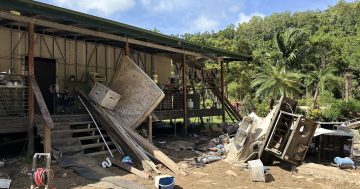Daryna Zadvirna* says the new technology has piqued the interest of authorities in war-torn Ukraine, and there’s hope it can revolutionise communication in defence, mining and natural disasters.
 Robotic radio towers developed by a Fremantle-based company have attracted international attention for their potential to revolutionise communications in defence, mining and natural disasters.
Robotic radio towers developed by a Fremantle-based company have attracted international attention for their potential to revolutionise communications in defence, mining and natural disasters.
Critical Infrastructure Technologies (CiTech) has spent the past three years developing the first-of-its-kind tower platforms, which were showcased to the WA government last week.
The 16-metre tower — able to withstand category four cyclones according to the developers — is powered by solar panels and lithium batteries, which all fold inside a shipping container-sized box.
The box can lift itself off a moving truck with in-built robotic legs and takes under 10 minutes to set up once it has been delivered to a location.
From there, the platform can provide connection to thousands of people within a 15-kilometre radius.
Tech can get entire towns back online
The technology was initially developed to service autonomous trucks and machinery in remote mining sites.
But the company hopes it can also be used in emergency situations.
“We can get an entire town back on the air again, in 30 minutes without anything other than a truck that can move it,” CiTech’s engineer Andrew Hill said.
“We found a way to build a room which could house the technology that phone companies need or mining companies need, or emergency services need or more importantly defence needs as well.”
Communication critical in natural disasters
CiTech chief executive Brenton Scott said the US, Latvian and Ukraine governments had expressed interest in the technology, with the former countries also hoping to set up its manufacturing.
“When power goes out, communication pretty much goes down,” Mr Scott said.
“We’ve had issues in WA when we had the fires back in February last year, townships just lose comms completely.
“You can’t communicate with first responders, you can’t communicate with people.
“Even in the US [with] the recent hurricane in Florida, comms were down for a very long time and people’s lives get lost.”
Bushfires caused widespread outages
An Australian Communications and Media Authority inquiry into the 2019-20 Black Summer bushfires, which burnt through 17 million hectares across the country, revealed wide scale network outages during the disaster.
The report found more than 1000 mobile towers and other telecommunication facilities were knocked out across south-east Australia and there were almost 900 outage incidents of four hours or more across fixed-line, mobile and fixed wireless networks.
The average time to restore the communications was 3.5 days.
Paul Fletcher, who was the federal communications minister at the time, said the report highlighted the need to strengthen critical telecommunications infrastructure during emergencies.
Similar issues were experienced in the aftermath of Tropical Cyclone Seroja in WA in April 2021 and storms in Victoria in June 2021, as power outages at single points of failure led to extended network outages across entire regions.
The federal government’s three-yearly Regional Telecommunications Review in 2022 echoed those sentiments.
The report found that while it was too expensive to upgrade battery back-up at all phone towers, disaster-prone areas should receive targeted funding.
“In this challenging landscape, we argue there is a role for both government and industry to do more to ensure the reliability, resilience and redundancy of regional telecommunications networks,” the report said.
Defence interest from Ukraine
The Ministry of Defence in Ukraine put in a request for 50 of CiTech’s mobile platforms earlier this year.
The company hopes the order may come as part of a future Australian aid package.
“Ukraine is very interested in what we’re doing,” Mr Scott said.
“Fixed infrastructure is being destroyed and obviously the power stations have been targeted.”
The International Telecommunication Union released a report in September which revealed wide-scale damage to Ukraine’s communications infrastructure in more than 10 of 24 of the country’s regions.
The report estimated it would take $1.79 billion to restore its telecommunications infrastructure to pre-war levels.
Towers could bolster border security
Mr Scott said the US was looking at potentially using the platforms for both communication and surveillance purposes.
“From a defence side, that extends through to border security,” Mr Scott said.
“There are already papers out through the US government about money being put aside to get autonomous border security systems put in place.
“We’ve also had the Latvian Ambassador out [here] last week.”
The whole Eastern Bloc, from Estonia, Latvia, Lithuania, right down to Poland, because of their location, they’re all building their defence capabilities.”
Tech has ‘potential’: expert
Electronic engineering professor at the University of WA, David Huang said the capability of the platforms was impressive but the product was still in its infancy.
“The system definitely has some potential,” Mr Huang said.
“It’s exciting, I’m glad it’s been developed here in Fremantle.
“But like with any product, particularly for such a product that aims at tough environments — the battlefield, disaster zones — then definitely its needs to be tested.”
Mr Huang likened the robotic container for the communication tower as a house that has the potential to be fitted with other appliances, depending on the situation.
He added the platforms were expensive, at $1 million each, but would save on deployment and building costs in comparison to fixed towers.
Representatives from Deputy Premier Roger Cook’s office met with the company on Friday to discuss local manufacturing.
“CiTech were provided with a high-level overview of potential avenues for state and federal government support if required,” a spokesman said.
“[Its] portable communications towers are a great example of WA’s homegrown advanced manufacturing capabilities.”
*Daryna Zadvirna, reporter at ABC Perth.
This article first appeared at abc.net.au











